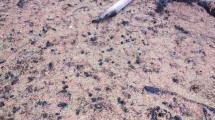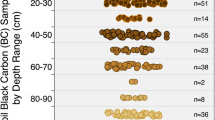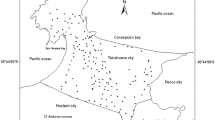Abstract
Urban soils contain significant amounts of black carbon (BC) from biomass and fossil fuel combustion and regard to be a pool of BC. BC in urban soils has multiple effects on environmental processes in urban system, such as global climate change, air quality, and public health. Urban topsoil samples (0–10 cm) were collected from Anshan, Liaoning Province, northeast China, which is one of the most important old steel industrial bases in China. The BC in urban topsoils was extracted using the density method. Their chemical composition, morphology, molecular structure, and stable carbon isotopic composition were examined using elemental analysis, scanning electron microscopy with energy-dispersive X-ray spectroscopy (SEM-EDS), Fourier transform infrared spectroscopy (FTIR), thermogravimetric analysis (TGA), X-ray diffraction (XRD), and stable carbon isotope (δ13C). Elemental analysis shows that carbon content in the BC of studied soils ranged from 64.5 to 78.4%, with the average more than 70%. The O/C atomic ratio of BC is on average 0.18. The BC particle displays different morphology, including porous spherical, irregular porous fragmentary, and blocky shapes. The porous spherical BC particles has atomic molar O/C ratio determined by SEM-EDS ranging from 0.04 to 0.37. XRD indicates that BC exists in mainly combining with mineral phases hematite (Fe2O3), kaolinite (Al2Si2O5(OH)4), quartz (SiO2), and calcite (CaCO3). The FTIR spectra of BC particles show major bands at approximately 3400 cm−1 (O–H), 2920 cm−1 (C = H), 1600 cm−1 (C = C), 1230 cm−1 (C = O), and 1070 cm−1 (C = O). The stable carbon isotope (δ13C) of BC ranges from −24.48 to −23.18‰ with the average of −23.79 ± 0.39‰. The concentration of BC in the industrial area is significantly (p < 0.05) higher than that in the roadside area. The BC of industrial area is characterized by porous spherical structure, suggesting that they are mainly derived from fossil fuel combustion. Results indicated that a combination of atomic O/C ratio, porous structure, and stable carbon isotopic (δ13C) of BC could reflect effectively the origin of BC in urban topsoils. It could conclude that BC in Anshan urban topsoil was mainly from fossil fuel combustion.





Similar content being viewed by others
References
Bond TC, Streets DG, Yarber KF, Nelson SM, Woo JH, Klimont Z (2004) A technology-based global inventory of black and organic carbon emissions from combustion. J Geophys Res 109:D14203. https://doi.org/10.1029/2003JD003697
Brodowski S, Amelung W, Haumaier L, Abetz C, Zech W (2005) Morphological and chemical properties of black carbon in physical soil fractions as revealed by scanning electron microscopy and energy-dispersive X-ray spectroscopy. Geoderma 128:116–129
Brown-Steiner B, Hess P, Chen J, Donaghy K (2016) Black carbon emissions from trucks and trains in the midwestern and northeastern United States from 1977 to 2007. Atmos Environ 129:155–166
Chen B, Andersson A, Lee M, Kirillova EN, Xiao Q, Krusa M, Shi M, Hu K, Lu Z, Streets DG, Du K, Gustafsson O (2013) Source forensics of black carbon aerosols from China. Environ Sci Technol 47:9102–9108
Chia CH, Gong B, Joseph SD, Marjo CE, Munroe P, Rich AM (2012) Imaging of mineral-enriched biochar by FTIR. Raman SEM-EDX Vib Spectrosc 62:248–257
Chun Y, Sheng GY, Chiou CT, Xing BS (2004) Compositions and sorptive properties of crop residue-derived chars. Environ Sci Technol 38:4649–4655
Dachs J, Eisenreich SJ (2000) Adsorption onto aerosol soot carbon dominates gas-particle partitioning of polycyclic aromatic hydrocarbons. Environ Sci Technol 34:3690–3697
Das O, Wang Y, Hsieh Y (2010) Chemical and carbon isotopic characteristics of ash and smoke derived from burning of C3 and C4 grasses. Org Geochem 41:263–269
Duarte RMBO, Santos EBH, Pio CA, Duarte AC (2007) Comparison of structural features of water-soluble organic matter from atmospheric aerosols with those of aquatic humic substances. Atmos Environ 41:8100–8113
Duarte RMBO, Freire SMSC, Duarte AC (2015) Investigating the water-soluble organic functionality of urban aerosols using two-dimensional correlation of solid-state C-13 NMR and FTIR spectral data. Atmos Environ 116:245–252
Farquhar GD, Ehleringer JR, Hubick KT (1989) Carbon istope discrimination and photosynthesis. Annu Rev Plant Physiol Plant Mol Biol 40:503–537
Feng Y, Chen Y, Guo H, Zhi G, Xiong S, Li J, Sheng G, Fu J (2009) Characteristics of organic and elemental carbon in PM2.5 samples in Shanghai, China. Atmos Res 92:434–442
Forbes MS, Raison RJ, Skjemstad JO (2006) Formation, transformation and transport of black carbon (charcoal) in terrestrial and aquatic ecosystems. Sci Total Environ 370:190–206
Gao C, Knorr KH, Yu Z, He J, Zhang S, Lu X, Wang G (2016) Black carbon deposition and storage in peat soils of the Changbai Mountain, China. Geoderma 273:98–105
Glaser B, Balashov E, Haumaier L, Guggenberger G, Zech W (2000) Black carbon in density fraction of anthropogenic soils of the Brazilian Amazon region. Org Geochem 31:669–678
Glaser B, Dreyer A, Bock M, Fiedler S, Mehring M, Heitmann T (2005) Source apportionment of organic pollutions of a highway-traffic-influenced urban area in Bayreuth (Germany) using biomarker and stable carbon isotope signatures. Environ Sci Technol 39:3911–3917
Goldberg ED (1985) Black carbon in the environment. Wiley, New York
Griffin JJ, Goldberg ED (1981) Sphericity as a characteristic of solids from fossil fuel burning in a Lake Michigan sediment. Geochim Cosmochim Acta 45:763–769
Guo Y, Bustin RM (1998) FTIR spectroscopy and reflectance of modern charcoals and fungal decayed woods: implications for studies of inertinite in coals. Int J Coal Geol 37:29–53
Gustafsson O, Gschwend PM (1997) Aquatic colloids: concepts, definitions, and current challenges. Limnol Oceanogr 42:519–528
Hamilton GA, Hartnett HE (2013) Soot black carbon concentration and isotopic composition in soils from an arid urban ecosystem. Org Geochem 59:87–94
Hammes K, Smernik RJ, Skjemstad JO, Herzog A, Vogt UF, Schmidt MWI (2006) Synthesis and characterisation of laboratory-charred grass straw (Oryza saliva) and chestnut wood (Castanea sativa) as reference materials for black carbon quantification. Org Geochem 37:1629–1633
Hung NTQ, Lee SB, Hang NT, Kongpran J, Oanh NTK, Shim SG, Bae GN (2014) Charaterization of black carbon at roadside sites and long vehicle roadways in the Bangkok Metropolitan Region. Atmos Environ 92:231–239
Kawashima H, Haneishi Y (2012) Effects of combustion emissions from the Eurasian continent in winter on seasonal δ13C of elemental carbon in aerosols in Japan. Atmos Environ 46:568–579
Keiluweit M, Nico PS, Johnson MG, Kleber M (2010) Dynamic molecular structure of plant biomass-derived black carbon (biochar). Environ Sci Technol 44:1247–1253
Kuhlbusch TAJ (1998) Black carbon and the carbon cycle. Science 280:1903–1904
Kuhlbusch TAJ, Crutzen PJ (1995) Toward a global estimate of black carbon in residues of vegetation fires representing a sink of atmospheric CO2 and a source of O2. Glob Biogeochem Cycles 9:491–501
Lim B, Cachier H (1996) Determination of black carbon by chemical oxidation and thermal treatment in recent marine and lake sediments and Cretaceous-Tertiary clays. Chem Geol 131:143–154
Liu S, Xia X, Zhai Y, Wang R, Liu T, Zhang S (2011) Black carbon (BC) in urban and surrounding rural soils of Beijing, China: spatial distribution and relationship with polycyclic aromatic hydrocarbons (PAHs). Chemosphere 82:23–228
Liu L, Song Y, Cui L, Hao Z (2013) Stable carbon isotopic composition of black carbon in surface soils as a proxy for reconstructing vegetation on the Chinese Loess Plateau. Palaeogeogr Palaeoclimatol Palaeoecol 388:109–114
Lopez-Veneroni D (2009) The stable carbon isotope composition of PM2.5 and PM10 in Mexico City metropolitan area air. Atmos Environ 43:4491–4502
Masiello CA, Druffel ERM (1998) Black carbon in deep-sea sediments. Science 280:1911–1913
Menon S, Hansen J, Nazarenko L, Luo YF (2002) Climate effects of black carbon aerosols in China and India. Science 297:2250–2253
Nam JJ, Gustafsson O, Kurt-Karakus P, Breivik K, Steinnes E, Jones KC (2008) Relationships between organic matter, black carbon and persistent organic pollutants in European background soils: implications for sources and environmental fate. Environ Pollut 156:809–817
Ramanathan V, Carmichael G (2008) Global and regional climate changes due to black carbon. Nat Geosci 1:221–227
Roscoe R, Buurman P, Velthorst EJ, Vasconcellos CA (2001) Soil organic matter dynamics in density and particle size fractions as revealed by the 13C/12C isotopic ratio in a Cerrado’s oxisol. Geoderma 104(3–4):185–202
Rose NL, Juggins S, Watt J (1999) The characterisation of carbonaceous fly-ash particles from major European fossil-fuel types and applications to environmental samples. Atmos Environ 33:2699–2713
Safai PD, Raju MP, Budhavant KB, Rao PSP, Devara PCS (2013) Long term studies on characteristics of black carbon aerosols over a tropical urban station Pune, India. Atmos Res 132-133:173–184
Safai PD, Raju MP, Rao PSP, Pandithurai G (2014) Characterization of carbonaceous aerosols over the urban tropical location and a new approach to evaluate their climatic importance. Amos Environ 92:493–500
Schimmelpfennig S, Glaser B (2012) One step forward toward characterization: some important material properties to distinguish biochars. J Environ Qual 41:1001–1013
Schmidt MWI, Noack AG (2000) Black carbon in soils and sediments: analysis, distribution, implications, and current challenges. Glob Biogeochem Cycles 14:777–793
Stoffyn-Egli P, Potter TM, Leonard JD, Pocklington R (1997) The identification of black carbon particles with the analytical scanning electron microscope: methods and initial results. Sci Total Environ 198:211–223
Tang Y, Han G, Xu Z (2013) Black carbon in the atmospheric dust of Beijing City and its north area. Acta Sci Circumst 33:332–338 (in Chinese with English abstract)
Wang X, Cui LL, Xiao JL, Ding ZL (2013) Stable carbon isotope of black carbon in lake sediments as an indicator of terrestrial environmental changes: an evaluation on paleorecord from Daihai Lake, Inner Mongolia, China. Chem Geol 347:123–134
Wang Q, Liu M, Yu Y, Du F, Wang X (2014) Black carbon in soils from different land use areas of Shanghai, China: level, sources and relationship with polycyclic aromatic hydrocarbons. Appl Geochem 47:36–43
Wang H, An J, Zhu B, Shen L, Duan Q, Shi Y (2017) Characteristics of carbonaceous aerosol in a typical industrial city—Nanjing in Yangtze River Delta, China: size distributions, seasonal variations, and sources. Atmosphere 8:73
Widory D, Roy S, Le Moullec Y, Goupil G, Cocherie A, Guerrot C (2004) The origin of atmospheric particles in Paris: a view through carbon and lead isotopes. Atmos Environ 38:953–961
Wiedner K, Fischer D, Walther S, Criscuoli I, Favilli F, Nelle O, Glaser B (2005) Acceleration of biochar surface oxidation during compositing? J Agric Food Chem 63:3830–3837
Zhan C, Zhang J, Cao J, Han Y, Wang P, Zheng J, Yao R, Liu H, Li H, Xiao W (2016) Characteristics and sources of black carbon in atmospheric dustfall particles from Huangshi, China. Aerosol Air Qual Res 16:2096–2106
Zong YT, Xiao Q, Lu SG (2016) Black carbon (BC) of urban topsoil of steel industrial city (Anshan), northeastern China: concentration, source identification and environmental implication. Sci Total Environ 569-570:990–996
Funding
The research was supported by National Natural Science Foundation of China (41371236).
Author information
Authors and Affiliations
Corresponding author
Additional information
Responsible editor: Philippe Garrigues
Rights and permissions
About this article
Cite this article
Zong, Y., Xiao, Q. & Lu, S. Morphology, molecular structure, and stable carbon isotopic composition of black carbon (BC) in urban topsoils. Environ Sci Pollut Res 25, 3301–3312 (2018). https://doi.org/10.1007/s11356-017-0674-y
Received:
Accepted:
Published:
Issue Date:
DOI: https://doi.org/10.1007/s11356-017-0674-y




